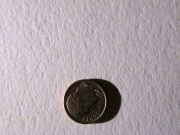Difference between revisions of "Blotting paper"
Jump to navigation
Jump to search
| (3 intermediate revisions by 2 users not shown) | |||
| Line 8: | Line 8: | ||
blotter; drinking paper; absorbent paper, filter paper; paper towel; grey paper; papier buvard (Fr.) | blotter; drinking paper; absorbent paper, filter paper; paper towel; grey paper; papier buvard (Fr.) | ||
| − | == | + | == Applications == |
| + | |||
| + | == Personal Risks == | ||
| + | |||
| + | == Physical and Chemical Properties == | ||
pH = 7-8 | pH = 7-8 | ||
| − | == | + | == Resources and Citations == |
* G.S.Brady, ''Materials Handbook'', McGraw-Hill Book Co., New York, 1971 Comment: p. 574 | * G.S.Brady, ''Materials Handbook'', McGraw-Hill Book Co., New York, 1971 Comment: p. 574 | ||
Latest revision as of 09:36, 15 October 2020
Description
An Absorbent paper used to soak up excess liquids and moisture, especially ink on writing paper. The unsized paper is bulky and porous with very little strength. There is a wide variety of blotting paper available ranging from high grade rag papers to chemical and mechanical pulp papers. Most are acid-free with a neutral PH.
Synonyms and Related Terms
blotter; drinking paper; absorbent paper, filter paper; paper towel; grey paper; papier buvard (Fr.)
Applications
Personal Risks
Physical and Chemical Properties
pH = 7-8
Resources and Citations
- G.S.Brady, Materials Handbook, McGraw-Hill Book Co., New York, 1971 Comment: p. 574
- Art and Architecture Thesaurus Online, http://www.getty.edu/research/tools/vocabulary/aat/, J. Paul Getty Trust, Los Angeles, 2000
- The Dictionary of Paper, American Paper Institute, New York, Fourth Edition, 1980
- E.J.LaBarre, Dictionary and Encyclopedia of Paper and Paper-making, Swets & Zeitlinger, Amsterdam, 1969
- Matt Roberts, Don Etherington, Bookbinding and the Conservation of Books: a Dictionary of Descriptive Terminology, U.S. Government Printing Office, Washington DC, 1982
- Marjorie Shelley, The Care and Handling of Art Objects, The Metropolitan Museum, New York, 1987
- Silvie Turner, Which Paper?, Design Press, New York, 1991
- Edward Reich, Carlton J. Siegler, Consumer Goods: How to Know and Use Them, American Book Company, New York City, 1937
- Ceramics and Glass Conservation Section, List of Workshop Materials, The British Museum, London
- Conservation Support Systems, Catalog, 1997
